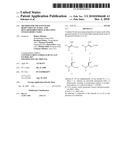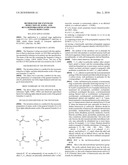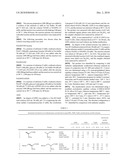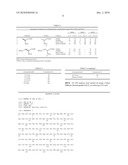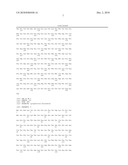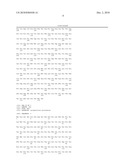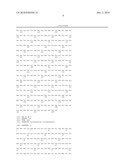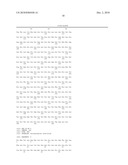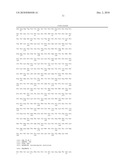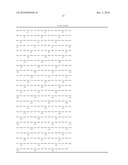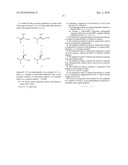Patent application title: METHOD FOR THE ENZYMATIC REDUCTION OF ALPHA- AND BETA-DEHYDROAMINO ACIDS USING ENOATE REDUCTASES
Inventors:
Rainer Stürmer (Rodersheim-Gronau, DE)
Rainer Stürmer (Rodersheim-Gronau, DE)
Rainer Stürmer (Rodersheim-Gronau, DE)
Bernhard Hauer (Fussgonheim, DE)
Thomas Friedrich (Darmstadt, DE)
Kurt Faber (Graz, AT)
Kurt Faber (Graz, AT)
Melanie Hall (Plouarzel, FR)
Clemens Stückler (Graz, AT)
Clemens Stückler (Graz, AT)
IPC8 Class: AC12P1304FI
USPC Class:
435106
Class name: Chemistry: molecular biology and microbiology micro-organism, tissue cell culture or enzyme using process to synthesize a desired chemical compound or composition preparing alpha or beta amino acid or substituted amino acid or salts thereof
Publication date: 2010-12-02
Patent application number: 20100304448
Claims:
1. A method for the enzymatic preparation of amino acids of the general
formula (3) or (4) from alpha-dehydroamino acids of the general formula
(1) or (2) ##STR00011## wherein R1, R2 are independently of one
another H, C1-C6 alkyl, C2-C6 alkenyl, an optionally
substituted carbo- or heterocyclic, aromatic or nonaromatic radical, or
an alkylaryl radical, or a carboxyl radical (--COOR),R3 is H,
formyl, acetyl, propionyl, benzyl, benzyloxycarbonyl, BOC, Alloc,R is H,
C1-C6 alkyl, aryl,by reducing a compound of the formula (1) or
(2) in the presence of a reductase(i) comprising at least one of the
polypeptide sequences SEQ ID NO:1, 2, 3, 4, 5, 6, or(ii) having a
functionally equivalent polypeptide sequence which has at least 80%
sequence identity with SEQ ID NO:1, 2, 3, 4, 5, 6.
2. The method as claimed in claim 1, wherein the reduction is carried out using NADPH or NADH as cofactor.
3. The method as claimed in claim 2, wherein the cofactor used is enzymatically regenerated.
4. The method as claimed in claim 3, wherein the cofactor is regenerated by glucose dehydrogenase or formate dehydrogenase or a secondary alcohol.
5. The method of claim 1, wherein the reduction is carried out in an aqueous, aqueous-alcoholic or alcoholic reaction medium.
6. The method of claim 1, wherein the reductase is present in an immobilized state.
7. The method of claim 1, wherein the enzyme is selected from among Bacillus subtilis and Lycopersicum esculentum reductases.
8. The method of claim 1, wherein a compound of the formula (1) is reacted, in whichR1 is H, R2 is H, R3 is acetyl.
9. The method of claim 1, wherein the reaction is carried out at a temperature ranging from 0 to 45.degree. C. and/or at a pH ranging from 6 to 8
10. A use of a compound of the formula (3) or (4), prepared by a method of claim 1, as an intermediate for chemical or enzymatic active agent synthesis.
Description:
RELATED APPLICATIONS
[0001]This application is a national stage application under 35 U.S.C. §371 of PCT/EP2008/066977, filed Dec. 8, 2008, which claims benefit of European application 07122758.1, filed Dec. 10, 2007.
SUBMISSION OF SEQUENCE LISTING
[0002]The Sequence Listing associated with this application is filed in electronic format via EFS-Web and hereby is incorporated by reference in its entirety into the specification. The name of the text file containing the Sequence Listing is Sequence_Listing--12810--01026_US.txt. The size of the text file is 21 KB, and the text file was created on Jun. 8, 2010.
BACKGROUND OF THE INVENTION
[0003]The invention relates to a method for the enzymatic reduction of alpha- and beta-dehydroamino acids of the general formulae (1) and (2).
[0004]The object was to provide a method for the enzymatic preparation of compounds of the general formulae (3) and (4), particularly one with a high chemical yield and very good stereoselectivity.
BRIEF SUMMARY OF THE INVENTION
[0005]The above object has been achieved by using the reductases YqjM, OPR1, OPR3 and functional equivalents thereof for reducing alpha-dehydroamino acids of the general formulae (1) and (2).
DETAILED DESCRIPTION OF THE INVENTION
[0006]The invention relates to a method for the enzymatic preparation of amino acids of the general formula (3) or (4) from alpha-dehydroamino acids of the general formula (1) or (2)
##STR00002##
wherein R1, R2 are independently of one another H, C1-C6 alkyl, C2-C6 alkenyl, an optionally substituted carbo- or heterocyclic, aromatic or nonaromatic radical, or an alkylaryl radical, or a carboxyl radical (--COOR),R3 is H, formyl, acetyl, propionyl, benzyl, benzyloxycarbonyl, BOC, Alloc,R is H, C1-C6 alkyl, aryl,by reducing a compound of the formula (1) or (2) in the presence of a reductase(i) comprising at least one of the polypeptide sequences SEQ ID NO:1, 2, 3, 4, 5, 6, or(ii) having a functionally equivalent polypeptide sequence which has at least 80% sequence identity with SEQ ID NO:1, 2, 3, 4, 5, 6.
[0007]The method of the invention can in principle be carried out both with purified or enriched enzyme itself and with microorganisms which express this enzyme naturally or recombinantly, or with cell homogenates derived therefrom.
[0008]Unless stated otherwise, the meanings are: [0009]C1-C6-alkyl in particular methyl, ethyl, propyl, butyl, pentyl or hexyl, and the corresponding analogs which are branched one or more times, such as i-propyl, i-butyl, sec-butyl, tert-butyl, i-pentyl or neopentyl, with preference in particular for said C1-C4-alkyl radicals; [0010]C2-C6-alkenyl in particular the monounsaturated analogs of the abovementioned alkyl radicals having 2 to 6 carbon atoms, with preference in particular for the corresponding C2-C4-alkenyl radicals. [0011]Carbo- and heterocyclic aromatic or nonaromatic rings in particular optionally fused rings having 3 to 12 carbon atoms and optionally 1 to 4 heteroatoms such as N, S and O, in particular N or O. Examples which may be mentioned are cyclopropyl, cyclobutyl, cyclopentyl, cyclohexyl, cycloheptyl, the mono- or polyunsaturated analogs thereof such as cyclobutenyl, cyclopentenyl, cyclohexenyl, cycloheptenyl, cyclohexadienyl, cycloheptadienyl; phenyl and naphthyl; and 5- to 7-membered saturated or unsaturated heterocyclic radicals having 1 to 4 heteroatoms which are selected from O, N and S, where the heterocycle may optionally be fused to a further heterocycle or carbocycle. Mention should be made in particular of heterocyclic radicals derived from pyrrolidine, tetrahydrofuran, piperidine, morpholine, pyrrole, furan, thiophene, pyrazole, imidazole, oxazole, thiazole, pyridine, pyran, pyrimidine, pyridazine, pyrazine, coumarone, indole and quinoline. The cyclic radicals, but also the abovementioned alkyl and alkenyl radicals, may optionally be substituted one or more times, such as, for example, 1, 2 or 3 times. Mention should be made as example of suitable substituents of: halogen, in particular F, Cl, Br; --OH, --SH, --NO2, --NH3, --SO3H, C1-C4-alkyl and C2-C4-alkenyl, C1-C4-alkoxy; and hydroxy-C1-C4-alkyl; where the alkyl and alkenyl radicals are as defined above, and the alkoxy radicals are derived from the above-defined corresponding alkyl radicals. [0012]BOC is the tert-butoxycarbonyl (protective) group [0013]Alloc is the allyoxylcarbonyl (protective) group
[0014]The cyclic radicals listed above may be both carbocycles, i.e. the cycle is composed of carbon atoms only, and heterocycles, i.e. the cycle comprises heteroatoms such as O; S; N. If desired, these carbo- or heterocycles may also additionally be substituted.
[0015]The enzymatic reductions of dehydroalanine and dehydroaspartate are particularly advantageous embodiments of the invention.
[0016]The reductases suitable for the method of the invention (which are occasionally also referred to as enoate reductases) have a polypeptide sequence as shown in SEQ ID NO:1, 2, or 3 or a polypeptide sequence which has at least 80%, for example at least 90%, or at least 95% and in particular at least 97%, 98% or 99% sequence identity with SEQ ID NO: 1, 2, 3, 4, 5 or 6.
[0017]A polypeptide having SEQ ID NO:1 is known as YqjM from Bacillus subtilis. (UniprotKB/Swissprot entry P54550).
[0018]A polypeptide having SEQ ID NO:2 is encoded by the tomato OPR1 gene. (UniprotKB/Swissprot entry Q9XG54).
[0019]A polypeptide having SEQ ID NO:3 is encoded by the tomato OYPR3 gene (UniprotKB/Swissprot entry Q9FEW9).
[0020]A polypeptide having SEQ ID NO:4 is known as Saccharomyces carlsbergensis OYEZ (Genbank Q02899).
[0021]A polypeptide having SEQ ID NO:5 is encoded by the OYE2 gene from baker's yeast (Saccharomyces cerevisiae Gene locus YHR179W) (Genbank Q03558).
[0022]A polypeptide having SEQ ID NO:6 is encoded by the OYE3 gene from baker's yeast (Saccharomyces cerevisiae Gene locus YPL171C) (Genbank P 41816).
[0023]The sequence identity is to be ascertained for the purposes described herein by the "GAP" computer program of the Genetics Computer Group (GCG) of the University of Wisconsin, and the version 10.3 using the standard parameters recommended by GCG is to be employed.
[0024]Such reductases can be obtained starting from SEQ ID NO: 1, 2, 3, 4, 5, 6 by targeted or randomized mutagenesis methods known to the skilled worker. An alternative possibility is, however, also to search in microorganisms, preferably in those of the genera Alishewanella, Alterococcus, Aquamonas, Aranicola, Arsenophonus, Azotivirga, Brenneria, Buchnera (aphid P-endosymbionts), Budvicia, Buttiauxella, Candidatus Phlomobacter, Cedecea, Citrobacter, Dickeya, Edwardsiella, Enterobacter, Erwinia, Escherichia, Ewingella, Grimontella, Hafnia, Klebsiella, Kluyvera, Leclercia, Leminorella, Moellerella, Morganella, Obesumbacterium, Pantoea, Pectobacterium, Photorhabdus, Plesiomonas, Pragia, Proteus, Providencia, Rahnella, Raoultella, Salmonella, Samsonia, Serratia, Shigella, Sodalis, Tatumella, Trabulsiella, Wigglesworthia, Xenorhabdus, Yersinia, Yokenella or Zymomonas for reductases which catalyze the abovementioned model reaction and whose amino acid sequence already has the required sequence identity to SEQ ID NO: 1, 2, 3, 4, 5, 6 or is obtained by mutagenesis methods.
[0025]The reductase can be used in purified or partly purified form or else in the form of the microorganism itself. Methods for obtaining and purifying dehydrogenases from microorganisms are well known to the skilled worker.
[0026]The enantioselective reduction with the reductase preferably takes place in the presence of a suitable cofactor (also referred to as cosubstrate). Cofactors normally used for reduction of the ketone are NADH and/or NADPH. Reductases can in addition be employed as cellular systems which inherently comprise cofactor, or alternative redox mediators can be added (A. Schmidt, F. Hollmann and B. Buhler "Oxidation of Alcohols" in K. Drauz and H. Waldmann, Enzyme Catalysis in Organic Synthesis 2002, Vol. III, 991-1032, Wiley-VCH, Weinheim).
[0027]The enantioselective reduction with the reductase additionally preferably takes place in the presence of a suitable reducing agent which regenerates cofactor oxidized during the reduction. Examples of suitable reducing agents are sugars, in particular hexoses such as glucose, mannose, fructose, and/or oxidizable alcohols, especially ethanol, propanol or isopropanol, and formate, phosphite or molecular hydrogen. To oxidize the reducing agent and, associated therewith, to regenerate the coenzyme, it is possible to add a second dehydrogenase such as, for example, glucose dehydrogenase when glucose is used as reducing agent, or formate dehydrogenase when formate is used as reducing agent. This can be employed as free or immobilized enzyme or in the form of free or immobilized cells. Preparation thereof can take place either separately or by coexpression in a (recombinant) reductase strain.
[0028]A preferred embodiment of the claimed method is to regenerate the cofactors by an enzymatic system in which a second dehydrogenase, particularly preferably a glucose dehydrogenase, is used.
[0029]It may further be expedient to add further additions promoting the reduction, such as, for example, metal salts or chelating agents such as, for example, EDTA.
[0030]The reductases used according to the invention can be employed free or immobilized. An immobilized enzyme means an enzyme which is fixed to an inert carrier. Suitable carrier materials and the enzymes immobilized thereon are disclosed in EP-A-1149849, EP-A-1 069 183 and DE-A 100193773, and the references cited therein. The disclosure of these publications in this regard is incorporated in its entirety herein by reference. Suitable carrier materials include for example clays, clay minerals such as kaolinite, diatomaceous earth, perlite, silicon dioxide, aluminum oxide, sodium carbonate, calcium carbonate, cellulose powder, anion exchanger materials, synthetic polymers such as polystyrene, acrylic resins, phenol-formaldehyde resins, polyurethanes and polyolefins such as polyethylene and polypropylene. The carrier materials are normally employed in a finely divided particulate form to prepare the carrier-bound enzymes, with preference for porous forms. The particle size of the carrier material is normally not more than 5 mm, in particular not more than 2 mm (grading curve). It is possible analogously to choose a free or immobilized form on use of the dehydrogenase as whole-cell catalyst. Examples of carrier materials are Ca alginate and carrageenan. Both enzymes and cells can also be crosslinked directly with glutaraldehyde (crosslinking to give CLEAs). Corresponding and further immobilization methods are described for example in J. Lalonde and A. Margolin "Immobilization of Enzymes" in K. Drauz and H. Waldmann, Enzyme Catalysis in Organic Synthesis 2002, Vol. III, 991-1032, Wiley-VCH, Weinheim.
[0031]The reaction can be carried out in aqueous or nonaqueous reaction media or in 2-phase systems or (micro)emulsions. The aqueous reaction media are preferably buffered solutions which ordinarily have a pH of from 4 to 8, preferably from 5 to 8. The aqueous solvent may, besides water, additionally comprise at least one alcohol, e.g. ethanol or isopropanol, or dimethyl sulfoxide.
[0032]Nonaqueous reaction media mean reaction media which comprise less than 1% by weight, preferably less than 0.5% by weight of water based on the total weight of the liquid reaction medium. The reaction can in particular be carried out in an organic solvent.
[0033]Suitable organic solvents are for example aliphatic hydrocarbons, preferably having 5 to 8 carbon atoms, such as pentane, cyclopentane, hexane, cyclohexane, heptane, octane or cyclooctane, halogenated aliphatic hydrocarbons, preferably having one or two carbon atoms, such as dichloromethane, chloroform, tetrachloromethane, dichloroethane or tetrachloroethane, aromatic hydrocarbons such as benzene, toluene, the xylenes, chlorobenzene or dichlorobenzene, aliphatic acyclic and cyclic ethers or alcohols, preferably having 4 to 8 carbon atoms, such as ethanol, isopropanol, diethyl ether, methyl tert-butyl ether, ethyl tert-butyl ether, dipropyl ether, diisopropyl ether, dibutyl ether, tetrahydrofuran or esters such as ethyl acetate or n-butyl acetate or ketones such as methyl isobutyl ketone or dioxane or mixtures thereof. The aforementioned ethers, especially tetrahydrofuran, are particularly preferably used.
[0034]The reduction with reductase can for example be carried out in an aqueous organic reaction medium such as, for example, water/isopropanol in any mixing ratio such as, for example, 1:99 to 99:1 or 10:90 to 90:10, or an aqueous reaction medium.
[0035]The substrate (1) or (2) is preferably employed in the enzymatic reduction in a concentration from 0.1 g/l to 500 g/l, particularly preferably from 1 g/l to 50 g/l, and can be fed in continuously or discontinuously.
[0036]Substrates (1) or (2) may be employed both as E/Z mixtures and as isomerically pure forms.
[0037]The enzymatic reduction ordinarily takes place at a reaction temperature below the deactivation temperature of the reductase employed and above -10° C. It is particularly preferably in the range from 0 to 100° C., in particular from 15 to 60° C. and specifically from 20 to 40° C., e.g. at about 30° C.
[0038]A possible procedure for example is to mix the substrate (1) or (2) with the reductase, the solvent and, if appropriate, the coenzymes, if appropriate a second dehydrogenase to regenerate the coenzyme and/or further reducing agents, thoroughly, e.g. by stirring or shaking. However, it is also possible to immobilize the reductase in a reactor, for example in a column, and to pass a mixture comprising the substrate and, if appropriate, coenzymes and/or cosubstrates through the reactor. For this purpose it is possible to circulate the mixture through the reactor until the desired conversion is reached.
[0039]The reduction is normally carried out until the conversion is at least 70%, particularly preferably at least 85% and in particular at least 95%, based on the substrate present in the mixture. The progress of the reaction, i.e. the sequential reduction of the double bond, can be followed here by conventional methods such as gas chromatography or high pressure liquid chromatography.
[0040]"Functional equivalents" or analogs of the specifically disclosed enzymes are, in the context of the present invention, polypeptides which differ therefrom and which still have the desired biological activity such as, for example, substrate specificity. Thus, "functional equivalents" mean for example enzymes which catalyze the model reaction and which have at least 20%, preferably 50%, particularly preferably 75%, very particularly preferably 90% of the activity of an enzyme comprising one of the amino acid sequences listed under SEQ ID NO:1, 2 or 3. Functional equivalents are additionally preferably stable between pH 4 to 10 and advantageously have a pH optimum between pH 5 and 8 and a temperature optimum in the range from 20° C. to 80° C.
[0041]"Functional equivalents" also mean according to the invention in particular mutants which have an amino acid other than that specifically mentioned in at least one sequence position of the abovementioned amino acid sequences but nevertheless have one of the abovementioned biological activities. "Functional equivalents" thus comprise the mutants obtainable by one or more amino acid additions, substitutions, deletions and/or inversions, it being possible for said modifications to occur in any sequence position as long as they lead to a mutant having the property profile according to the invention. Functional equivalence also exists in particular when the reactivity patterns agree qualitatively between mutant and unmodified polypeptide, i.e. for example identical substrates are converted at a different rate.
[0042]Examples of suitable amino acid substitutions are to be found in the following table:
TABLE-US-00001 Original residue Substitution examples Ala Ser Arg Lys Asn Gln; His Asp Glu Cys Ser Gln Asn Glu Asp Gly Pro His Asn; Gln Ile Leu; Val Leu Ile; Val Lys Arg; Gln; Glu Met Leu; Ile Phe Met; Leu; Tyr Ser Thr Thr Ser Trp Tyr Tyr Trp; Phe Val Ile; Leu
[0043]"Functional equivalents" in the above sense are also "precursors" of the described polypeptides and "functional derivatives".
[0044]"Precursors" are in this connection natural or synthetic precursors of the polypeptides with or without the desired biological activity.
[0045]"Functional derivatives" of polypeptides of the invention can likewise be prepared on functional amino acid side groups or on their N- or C-terminal end with the aid of known techniques. Such derivatives comprise, for example, aliphatic esters of carboxylic acid groups, amides of carboxylic acid groups, obtainable by reaction with ammonia or with a primary or secondary amine; N-acyl derivatives of free amino groups prepared by reaction with acyl groups; or O-acyl derivatives of free hydroxy groups prepared by reaction with acyl groups.
[0046]In the case where protein glycosylation is possible, "functional equivalents" of the invention comprise proteins of the type designated above in deglycosylated or glycosylated form, and modified forms obtainable by altering the glycosylation pattern.
[0047]"Functional equivalents" of course also comprise polypeptides which are obtainable from other organisms, and naturally occurring variants. For example, it is possible to establish ranges of homologous sequence regions by comparison of sequences, and to ascertain equivalent enzymes based on the specific requirements of the invention.
[0048]"Functional equivalents" likewise comprise fragments, preferably individual domains or sequence motifs, of the polypeptides of the invention, which have, for example, the desired biological function.
[0049]"Functional equivalents" are additionally fusion proteins which comprise one of the abovementioned polypeptide sequences or functional equivalents derived therefrom and at least one further, heterologous sequence which is functionally different therefrom in its functional N- or C-terminal linkage (i.e. with negligible mutual functional impairment of the parts of the fusion protein). Nonlimiting examples of such heterologous sequences are, for example, signal peptides or enzymes.
[0050]Homologs of the proteins of the invention can be identified by screening combinatorial libraries of mutants, such as, for example, truncation mutants. For example, a variegated library of protein variants can be generated by combinatorial mutagenesis at the nucleic acid level, such as, for example, by enzymatic ligation of a mixture of synthetic oligonucleotides. There is a large number of methods which can be used to prepare libraries of potential homologs from a degenerate oligonucleotide sequence. Chemical synthesis of a degenerate gene sequence can be carried out in an automatic DNA synthesizer, and the synthetic gene can then be ligated into a suitable expression vector. Use of a degenerate set of genes makes it possible to provide all the sequences which encode the desired set of potential protein sequences in one mixture. Methods for synthesizing degenerate oligonucleotides are known to the skilled worker (e.g. Narang, S. A. (1983) Tetrahedron 39:3; Itakura et al. (1984) Annu. Rev. Biochem. 53:323; Itakura et al., (1984) Science 198:1056; Ike et al. (1983) Nucleic Acids Res. 11:477).
[0051]Several techniques are known in the prior art for screening gene products of combinatorial libraries which have been prepared by point mutations or truncation, and for screening cDNA libraries for gene products having a selected property. These techniques can be adapted to the rapid screening of gene libraries which have been generated by combinatorial mutagenesis of homologs of the invention. The most commonly used techniques for screening large gene libraries, which are subject to high-throughput analysis, include the cloning of the gene library into replicable expression vectors, transformation of suitable cells with the resulting vector library and expression of the combinatorial genes under conditions under which detection of the desired activity facilitates isolation of the vector which encodes the gene whose product has been detected. Recursive ensemble mutagenesis (REM), a technique which increases the frequency of functional mutants in the libraries, can be used in combination with the screening tests to identify homologs (Arkin and Yourvan (1992) PNAS 89:7811-7815; Delgrave et al. (1993) Protein Engineering 6(3):327-331).
[0052]The invention further relates to nucleic acid sequences (single- and double-stranded DNA and RNA sequences such as, for example, cDNA and mRNA) which code for an enzyme having reductase activity according to the invention. Nucleic acid sequences which code for example for amino acid sequences shown in SEQ ID NO:1, 2 or 3 or characteristic partial sequences thereof are preferred.
[0053]All nucleic acid sequences mentioned herein can be prepared in a manner known per se by chemical synthesis from the nucleotide building blocks, such as, for example, by fragment condensation of individual overlapping complementary nucleic acid building blocks of the double helix. Chemical synthesis of oligonucleotides can take place, for example, in a known manner by the phosphoramidite method (Voet, Voet, 2nd edition, Wiley Press New York, pages 896-897). Addition of synthetic oligonucleotides and filling in of gaps using the Klenow fragment of DNA polymerase and ligation reactions, and general cloning methods are described in Sambrook et al. (1989), Molecular Cloning: A laboratory manual, Cold Spring Harbor Laboratory Press.
[0054]Further embodiments for carrying out the enzymatic reduction method of the invention:
[0055]The pH in the method of the invention is advantageously kept between pH 4 and 12, preferably between pH 4.5 and 9, particularly preferably between pH 5 and 8. A minimum of 98% ee is achieved.
[0056]It is possible to use for the method of the invention growing cells which comprise nucleic acids, nucleic acid constructs or vectors coding for the reductase. It is also possible to use resting or disrupted cells. Disrupted cells mean for example cells which have been made permeable by a treatment with, for example, solvents, or cells which have been disintegrated by an enzyme treatment, by a mechanical treatment (e.g. French press or ultrasound) or by any other method. The crude extracts obtained in this way are advantageously suitable for the method of the invention. Purified or partially purified enzymes can also be used for the method. Immobilized microorganisms or enzymes are likewise suitable and can advantageously be used in the reaction.
[0057]The method of the invention can be carried out batchwise, semi-batchwise or continuously.
[0058]The method can advantageously be carried out in bioreactors as described, for example, in Biotechnology, Vol. 3, 2nd edition, Rehm et al. editors (1993) especially chapter II.
[0059]The products prepared in the method of the invention may be isolated from the reaction medium by methods familiar to the skilled worker and purified, if desired. Said methods include distillation methods, chromatography methods, extraction methods and crystallization methods. The products may be purified to a substantially higher level by combining a plurality of these methods, as required.
[0060]The following examples are intended to illustrate the invention without, however, restricting it. Reference is made to the appended figures in this connection.
EXPERIMENTAL SECTION
General Protocol Regarding Asymmetric Bioreduction
[0061]The asymmetric bioreduction of the substrates was carried out according to the following general protocol using the isolated enzymes YqjM, OPR1, OPR3 and Zymomonas mobilis reductase.
[0062]The enzyme preparation (100-200 μg) was added to a solution of the substrate (5 mM) in Tris buffer, 50 mM ph/7.5 (0.8 ml), with the cofactor NADH or NADPH (15 mM), and the reaction was carried out with shaking (140 rpm) at 30° C. After 48 hours, the reaction mixture was extracted with ethyl acetate and the reaction products were analyzed by GC.
[0063]The following procedure was chosen when the cofactor recycling system was used:
NADH/FDH System
[0064]To a mixture of substrate (5 mM), oxidized cofactor NAD.sup.+ (100 μM), ammonium formate (20 mM) in Tris buffer 50 mM pH 7.5 (0.8 ml), FDH (10 u) was added, after the enzyme (100-200 μg) had been added, and the reaction was carried out at 30° C. (140 rpm) for 48 hours.
NADH/GDH
[0065]To a mixture of substrate (5 mM), oxidized cofactor NAD.sup.+ (100 μM), glucose (20 mM) in Tris buffer 50 mM pH 7.5 (0.8 ml), (D)-GDH (10 u) was added, after the enzyme (100-200 μg) had been added, and the reaction was carried out at 30° C. (140 rpm) for 48 hours.
NADPH/G6PDH
[0066]To a mixture of substrate (5 mM), oxidized cofactor NADP.sup.+ (10 μM), glucose 6-phosphate (20 mM) in Tris buffer 50 mM pH 7.5 (0.8 ml), G6PDH (10 u) was added, after the enzyme (100-200 μg) had been added, and the reaction was carried out at 30° C. (140 rpm) for 48 hours.
ADH
[0067]An aliquot of OPR1 was added to a Tris-HCl-buffered solution (0.8 ml, 50 mM, pH 7.5) comprising the substrate methyl 2-acetamidoacrylate (5 mM), the cosubstrate 2-propanol (3-60 mM, 0.6-12 mol equivalents) and the oxidized cofactor NAD+ (100 μM). ADH-A was added (approx. 2-3 U), and the mixture was stirred at 120 rpm at 30° C. for 42 h. The product was extracted with ethyl acetate (2×0.5 ml), the combined organic phases were dried over Na2SO4, and the samples obtained were analyzed by achiral GC.
[0068]ADH_A was expressed in E. coli BL21 (DE3) (vector pETv22b). After a thermal shock at 65° C. for 20 min., the ADH solution was used without any further purification.
[0069]An aliquot of the isolated enzyme was added to a Tris-HCl-buffered solution (0.8 ml, 50 mM, pH 7.5) comprising the substrate methyl 2-acetamidoacrylate (5 mM) and the cofactor NADH or NADPH (10 mM). The reaction mixture was stirred at 120 rpm at 30° C. for 64 h. The product was extracted with ethyl acetate (2×0.5 ml), the combined organic phases were dried over Na2SO4, and the samples obtained were analyzed by achiral GC.
[0070]The product was identified by comparing it with authentic independently synthesized reference material by means of coinjection into GC-MS and achiral GC. Conversion was determined using a 6% cyanopropylphenyl phase capillary column (Varian CP-1301, 30 m, 0.25 mm, 0.25 μm), detector temperature 240° C., injector temperature 250° C., split ratio 30:1. Temperature program for methyl 2-acetamidoacrylate and N-acetyl-alanine methyl ester: 120° C. for 2 min, 10° C./min to 160° C., 30° C./min to 200° C., sustained for 2 min. Retention times: 4.89 min and 5.12 min.
[0071]The enantiomeric excess was determined using a modified cyclodextrin capillary column (CHIRALDEX® B-TA, 40 m, 0.25 mm). Detector temperature 200° C., injector temperature 180° C., split ratio 20:1. Temperature program: 130° C. for 5 min, 2° C./min to 135° C., 15° C./min to 180° C., sustained for 2 min. Retention times: (R/S)- and (S/R)-5.18 and 5.35 min, resp. The absolute configuration is "S", identified by comparison with authentic samples.
TABLE-US-00002 TABLE 1 Asymmetric bioreduction of α-dehydroamino acid derivatives using OPR1, OPR3, YqjM, and Zymomonas mobilis reductase Zymomonas mobilis OPR1 OPR3 YqjM Reductase Substrate Product Cofactor c. % E.e. % c. % E.e. % c. % Ee % c. % E.e. % 1 2 3 4 ##STR00003## ##STR00004## NADH NADPH NAD.sup.+/FDHa NADP.sup.+/G6PDHb 16 21 63 31 91 95 >98 >98 <1 <1 n.d. n.d. n.d. n.d. -- -- 41 50 91 51 97 98 >98 >98 <1 <1 n.d. n.d. n.d. n.d. -- -- 5 6 7 8 ##STR00005## ##STR00006## NADH NADPH NAD.sup.+/FDHa NADP.sup.+/G6PDHb 19 21 98 31 >99 >99 >99 >99 <5 <5 n.d. n.d. n.d. n.d. -- -- 26 32 >99 35 >99 >99 >99 >99 <5 <5 n.d. n.d. n.d. n.d. -- --
TABLE-US-00003 TABLE 2 Asymmetric bioreduction of α-dehydroamino acid derivatives using OYE1, OYE2 and OYE3 OYE1 OYE2 OYE3 Substrate Product Cofactor c. % E.e. % c. % E.e. % c. % E.e. % 1 2 3 4 ##STR00007## ##STR00008## NADH NADPH NAD.sup.+/FDHa NADP.sup.+/G6PDHb 30 24 7 14 95 94 >98 >98 6 4 15 9 85 74 >98 >98 15 17 89 42 95 95 >98 >98 5 6 7 8 ##STR00009## ##STR00010## NADH NADPH NAD.sup.+/FDHa NADP.sup.+/G6PDHb <5 <5 n.d. n.d. n.d. n.d. -- -- n.c. n.c. n.d. n.d. -- -- -- -- 36 76 >99 49 23 10 57 39 aPDH = Formate dehydrogenase/format. bG6PDH = Glucose-6-phosphat dehydrogenase/Glucose-6-phosphate.
TABLE-US-00004 TABLE 3 [2-propanol] mM Conversion in % 3 (0.6 eq.) 54 6 (1.2 eq.) 90 7 (1.4 eq.) >99 8 (1.6 eq.) >99 10 (2 eq.) >99 20 (4 eq.) >99 60 (12 eq.) >99 Blank (no OPR1) <3
[0072]GC-FID analyses were carried out using a Varian 3800 gas chromatograph with H2 as carrier gas (14.5 psi).
Sequence CWU
1
61337PRTBacillus subtilis 1Ala Arg Lys Leu Phe Thr Pro Ile Thr Ile Lys Asp
Met Thr Leu Lys1 5 10
15Asn Arg Ile Val Met Ser Pro Met Cys Met Tyr Ser Ser His Glu Lys
20 25 30Asp Gly Lys Leu Thr Pro Phe
His Met Ala His Tyr Ile Ser Arg Ala 35 40
45Ile Gly Gln Val Gly Leu Ile Ile Val Glu Ala Ser Ala Val Asn
Pro 50 55 60Gln Gly Arg Ile Thr Asp
Gln Asp Leu Gly Ile Trp Ser Asp Glu His65 70
75 80Ile Glu Gly Phe Ala Lys Leu Thr Glu Gln Val
Lys Glu Gln Gly Ser 85 90
95Lys Ile Gly Ile Gln Leu Ala His Ala Gly Arg Lys Ala Glu Leu Glu
100 105 110Gly Asp Ile Phe Ala Pro
Ser Ala Ile Ala Phe Asp Glu Gln Ser Ala 115 120
125Thr Pro Val Glu Met Ser Ala Glu Lys Val Lys Glu Thr Val
Gln Glu 130 135 140Phe Lys Gln Ala Ala
Ala Arg Ala Lys Glu Ala Gly Phe Asp Val Ile145 150
155 160Glu Ile His Ala Ala His Gly Tyr Leu Ile
His Glu Phe Leu Ser Pro 165 170
175Leu Ser Asn His Arg Thr Asp Glu Tyr Gly Gly Ser Pro Glu Asn Arg
180 185 190Tyr Arg Phe Leu Arg
Glu Ile Ile Asp Glu Val Lys Gln Val Trp Asp 195
200 205Gly Pro Leu Phe Val Arg Val Ser Ala Ser Asp Tyr
Thr Asp Lys Gly 210 215 220Leu Asp Ile
Ala Asp His Ile Gly Phe Ala Lys Trp Met Lys Glu Gln225
230 235 240Gly Val Asp Leu Ile Asp Cys
Ser Ser Gly Ala Leu Val His Ala Asp 245
250 255Ile Asn Val Phe Pro Gly Tyr Gln Val Ser Phe Ala
Glu Lys Ile Arg 260 265 270Glu
Gln Ala Asp Met Ala Thr Gly Ala Val Gly Met Ile Thr Asp Gly 275
280 285Ser Met Ala Glu Glu Ile Leu Gln Asn
Gly Arg Ala Asp Leu Ile Phe 290 295
300Ile Gly Arg Glu Leu Leu Arg Asp Pro Phe Phe Ala Arg Thr Ala Ala305
310 315 320Lys Gln Leu Asn
Thr Glu Ile Pro Ala Pro Val Gln Tyr Glu Arg Gly 325
330 335Trp 2376PRTLycopersicon esculentum 2Met
Glu Asn Lys Val Val Glu Glu Lys Gln Val Asp Lys Ile Pro Leu1
5 10 15Met Ser Pro Cys Lys Met Gly
Lys Phe Glu Leu Cys His Arg Val Val 20 25
30Leu Ala Pro Leu Thr Arg Gln Arg Ser Tyr Gly Tyr Ile Pro
Gln Pro 35 40 45His Ala Ile Leu
His Tyr Ser Gln Arg Ser Thr Asn Gly Gly Leu Leu 50 55
60Ile Gly Glu Ala Thr Val Ile Ser Glu Thr Gly Ile Gly
Tyr Lys Asp65 70 75
80Val Pro Gly Ile Trp Thr Lys Glu Gln Val Glu Ala Trp Lys Pro Ile
85 90 95Val Asp Ala Val His Ala
Lys Gly Gly Ile Phe Phe Cys Gln Ile Trp 100
105 110His Val Gly Arg Val Ser Asn Lys Asp Phe Gln Pro
Asn Gly Glu Asp 115 120 125Pro Ile
Ser Cys Thr Asp Arg Gly Leu Thr Pro Gln Ile Arg Ser Asn 130
135 140Gly Ile Asp Ile Ala His Phe Thr Arg Pro Arg
Arg Leu Thr Thr Asp145 150 155
160Glu Ile Pro Gln Ile Val Asn Glu Phe Arg Val Ala Ala Arg Asn Ala
165 170 175Ile Glu Ala Gly
Phe Asp Gly Val Glu Ile His Gly Ala His Gly Tyr 180
185 190Leu Ile Asp Gln Phe Met Lys Asp Gln Val Asn
Asp Arg Ser Asp Lys 195 200 205Tyr
Gly Gly Ser Leu Glu Asn Arg Cys Arg Phe Ala Leu Glu Ile Val 210
215 220Glu Ala Val Ala Asn Glu Ile Gly Ser Asp
Arg Val Gly Ile Arg Ile225 230 235
240Ser Pro Phe Ala His Tyr Asn Glu Ala Gly Asp Thr Asn Pro Thr
Ala 245 250 255Leu Gly Leu
Tyr Met Val Glu Ser Leu Asn Lys Tyr Asp Leu Ala Tyr 260
265 270Cys His Val Val Glu Pro Arg Met Lys Thr
Ala Trp Glu Lys Ile Glu 275 280
285Cys Thr Glu Ser Leu Val Pro Met Arg Lys Ala Tyr Lys Gly Thr Phe 290
295 300Ile Val Ala Gly Gly Tyr Asp Arg
Glu Asp Gly Asn Arg Ala Leu Ile305 310
315 320Glu Asp Arg Ala Asp Leu Val Ala Tyr Gly Arg Leu
Phe Ile Ser Asn 325 330
335Pro Asp Leu Pro Lys Arg Phe Glu Leu Asn Ala Pro Leu Asn Lys Tyr
340 345 350Asn Arg Asp Thr Phe Tyr
Thr Ser Asp Pro Ile Val Gly Tyr Thr Asp 355 360
365Tyr Pro Phe Leu Glu Thr Met Thr 370
3753396PRTLycopersicon esculentum 3Met Ala Ser Ser Ala Gln Asp Gly Asn
Asn Pro Leu Phe Ser Pro Tyr1 5 10
15Lys Met Gly Lys Phe Asn Leu Ser His Arg Val Val Leu Ala Pro
Met 20 25 30Thr Arg Cys Arg
Ala Leu Asn Asn Ile Pro Gln Ala Ala Leu Gly Glu 35
40 45Tyr Tyr Glu Gln Arg Ala Thr Ala Gly Gly Phe Leu
Ile Thr Glu Gly 50 55 60Thr Met Ile
Ser Pro Thr Ser Ala Gly Phe Pro His Val Pro Gly Ile65 70
75 80Phe Thr Lys Glu Gln Val Arg Glu
Trp Lys Lys Ile Val Asp Val Val 85 90
95His Ala Lys Gly Ala Val Ile Phe Cys Gln Leu Trp His Val
Gly Arg 100 105 110Ala Ser His
Glu Val Tyr Gln Pro Ala Gly Ala Ala Pro Ile Ser Ser 115
120 125Thr Glu Lys Pro Ile Ser Asn Arg Trp Arg Ile
Leu Met Pro Asp Gly 130 135 140Thr His
Gly Ile Tyr Pro Lys Pro Arg Ala Ile Gly Thr Tyr Glu Ile145
150 155 160Ser Gln Val Val Glu Asp Tyr
Arg Arg Ser Ala Leu Asn Ala Ile Glu 165
170 175Ala Gly Phe Asp Gly Ile Glu Ile His Gly Ala His
Gly Tyr Leu Ile 180 185 190Asp
Gln Phe Leu Lys Asp Gly Ile Asn Asp Arg Thr Asp Glu Tyr Gly 195
200 205Gly Ser Leu Ala Asn Arg Cys Lys Phe
Ile Thr Gln Val Val Gln Ala 210 215
220Val Val Ser Ala Ile Gly Ala Asp Arg Val Gly Val Arg Val Ser Pro225
230 235 240Ala Ile Asp His
Leu Asp Ala Met Asp Ser Asn Pro Leu Ser Leu Gly 245
250 255Leu Ala Val Val Glu Arg Leu Asn Lys Ile
Gln Leu His Ser Gly Ser 260 265
270Lys Leu Ala Tyr Leu His Val Thr Gln Pro Arg Tyr Val Ala Tyr Gly
275 280 285Gln Thr Glu Ala Gly Arg Leu
Gly Ser Glu Glu Glu Glu Ala Arg Leu 290 295
300Met Arg Thr Leu Arg Asn Ala Tyr Gln Gly Thr Phe Ile Cys Ser
Gly305 310 315 320Gly Tyr
Thr Arg Glu Leu Gly Ile Glu Ala Val Ala Gln Gly Asp Ala
325 330 335Asp Leu Val Ser Tyr Gly Arg
Leu Phe Ile Ser Asn Pro Asp Leu Val 340 345
350Met Arg Ile Lys Leu Asn Ala Pro Leu Asn Lys Tyr Asn Arg
Lys Thr 355 360 365Phe Tyr Thr Gln
Asp Pro Val Val Gly Tyr Thr Asp Tyr Pro Phe Leu 370
375 380Gln Gly Asn Gly Ser Asn Gly Pro Leu Ser Arg Leu385
390 3954399PRTSaccharomyces
carlsbergensis 4Ser Phe Val Lys Asp Phe Lys Pro Gln Ala Leu Gly Asp Thr
Asn Leu1 5 10 15Phe Lys
Pro Ile Lys Ile Gly Asn Asn Glu Leu Leu His Arg Ala Val 20
25 30Ile Pro Pro Leu Thr Arg Met Arg Ala
Leu His Pro Gly Asn Ile Pro 35 40
45Asn Arg Asp Trp Ala Val Glu Tyr Tyr Thr Gln Arg Ala Gln Arg Pro 50
55 60Gly Thr Met Ile Ile Thr Glu Gly Ala
Phe Ile Ser Pro Gln Ala Gly65 70 75
80Gly Tyr Asp Asn Ala Pro Gly Val Trp Ser Glu Glu Gln Met
Val Glu 85 90 95Trp Thr
Lys Ile Phe Asn Ala Ile His Glu Lys Lys Ser Phe Val Trp 100
105 110Val Gln Leu Trp Val Leu Gly Trp Ala
Ala Phe Pro Asp Asn Leu Ala 115 120
125Arg Asp Gly Leu Arg Tyr Asp Ser Ala Ser Asp Asn Val Phe Met Asp
130 135 140Ala Glu Gln Glu Ala Lys Ala
Lys Lys Ala Asn Asn Pro Gln His Ser145 150
155 160Leu Thr Lys Asp Glu Ile Lys Gln Tyr Ile Lys Glu
Tyr Val Gln Ala 165 170
175Ala Lys Asn Ser Ile Ala Ala Gly Ala Asp Gly Val Glu Ile His Ser
180 185 190Ala Asn Gly Tyr Leu Leu
Asn Gln Phe Leu Asp Pro His Ser Asn Thr 195 200
205Arg Thr Asp Glu Tyr Gly Gly Ser Ile Glu Asn Arg Ala Arg
Phe Thr 210 215 220Leu Glu Val Val Asp
Ala Leu Val Glu Ala Ile Gly His Glu Lys Val225 230
235 240Gly Leu Arg Leu Ser Pro Tyr Gly Val Phe
Asn Ser Met Ser Gly Gly 245 250
255Ala Glu Thr Gly Ile Val Ala Gln Tyr Ala Tyr Val Ala Gly Glu Leu
260 265 270Glu Lys Arg Ala Lys
Ala Gly Lys Arg Leu Ala Phe Val His Leu Val 275
280 285Glu Pro Arg Val Thr Asn Pro Phe Leu Thr Glu Gly
Glu Gly Glu Tyr 290 295 300Glu Gly Gly
Ser Asn Asp Phe Val Tyr Ser Ile Trp Lys Gly Pro Val305
310 315 320Ile Arg Ala Gly Asn Phe Ala
Leu His Pro Glu Val Val Arg Glu Glu 325
330 335Val Lys Asp Lys Arg Thr Leu Ile Gly Tyr Gly Arg
Phe Phe Ile Ser 340 345 350Asn
Pro Asp Leu Val Asp Arg Leu Glu Lys Gly Leu Pro Leu Asn Lys 355
360 365Tyr Asp Arg Asp Thr Phe Tyr Gln Met
Ser Ala His Gly Tyr Ile Asp 370 375
380Tyr Pro Thr Tyr Glu Glu Ala Leu Lys Leu Gly Trp Asp Lys Lys385
390 3955399PRTSaccharomyces cerevisiae 5Pro Phe
Val Lys Asp Phe Lys Pro Gln Ala Leu Gly Asp Thr Asn Leu1 5
10 15Phe Lys Pro Ile Lys Ile Gly Asn
Asn Glu Leu Leu His Arg Ala Val 20 25
30Ile Pro Pro Leu Thr Arg Met Arg Ala Gln His Pro Gly Asn Ile
Pro 35 40 45Asn Arg Asp Trp Ala
Val Glu Tyr Tyr Ala Gln Arg Ala Gln Arg Pro 50 55
60Gly Thr Leu Ile Ile Thr Glu Gly Thr Phe Pro Ser Pro Gln
Ser Gly65 70 75 80Gly
Tyr Asp Asn Ala Pro Gly Ile Trp Ser Glu Glu Gln Ile Lys Glu
85 90 95Trp Thr Lys Ile Phe Lys Ala
Ile His Glu Asn Lys Ser Phe Ala Trp 100 105
110Val Gln Leu Trp Val Leu Gly Trp Ala Ala Phe Pro Asp Thr
Leu Ala 115 120 125Arg Asp Gly Leu
Arg Tyr Asp Ser Ala Ser Asp Asn Val Tyr Met Asn 130
135 140Ala Glu Gln Glu Glu Lys Ala Lys Lys Ala Asn Asn
Pro Gln His Ser145 150 155
160Ile Thr Lys Asp Glu Ile Lys Gln Tyr Val Lys Glu Tyr Val Gln Ala
165 170 175Ala Lys Asn Ser Ile
Ala Ala Gly Ala Asp Gly Val Glu Ile His Ser 180
185 190Ala Asn Gly Tyr Leu Leu Asn Gln Phe Leu Asp Pro
His Ser Asn Asn 195 200 205Arg Thr
Asp Glu Tyr Gly Gly Ser Ile Glu Asn Arg Ala Arg Phe Thr 210
215 220Leu Glu Val Val Asp Ala Val Val Asp Ala Ile
Gly Pro Glu Lys Val225 230 235
240Gly Leu Arg Leu Ser Pro Tyr Gly Val Phe Asn Ser Met Ser Gly Gly
245 250 255Ala Glu Thr Gly
Ile Val Ala Gln Tyr Ala Tyr Val Leu Gly Glu Leu 260
265 270Glu Arg Arg Ala Lys Ala Gly Lys Arg Leu Ala
Phe Val His Leu Val 275 280 285Glu
Pro Arg Val Thr Asn Pro Phe Leu Thr Glu Gly Glu Gly Glu Tyr 290
295 300Asn Gly Gly Ser Asn Lys Phe Ala Tyr Ser
Ile Trp Lys Gly Pro Ile305 310 315
320Ile Arg Ala Gly Asn Phe Ala Leu His Pro Glu Val Val Arg Glu
Glu 325 330 335Val Lys Asp
Pro Arg Thr Leu Ile Gly Tyr Gly Arg Phe Phe Ile Ser 340
345 350Asn Pro Asp Leu Val Asp Arg Leu Glu Lys
Gly Leu Pro Leu Asn Lys 355 360
365Tyr Asp Arg Asp Thr Phe Tyr Lys Met Ser Ala Glu Gly Tyr Ile Asp 370
375 380Tyr Pro Thr Tyr Glu Glu Ala Leu
Lys Leu Gly Trp Asp Lys Asn385 390
3956399PRTSaccharomyces cerevisiae 6Pro Phe Val Lys Gly Phe Glu Pro Ile
Ser Leu Arg Asp Thr Asn Leu1 5 10
15Phe Glu Pro Ile Lys Ile Gly Asn Thr Gln Leu Ala His Arg Ala
Val 20 25 30Met Pro Pro Leu
Thr Arg Met Arg Ala Thr His Pro Gly Asn Ile Pro 35
40 45Asn Lys Glu Trp Ala Ala Val Tyr Tyr Gly Gln Arg
Ala Gln Arg Pro 50 55 60Gly Thr Met
Ile Ile Thr Glu Gly Thr Phe Ile Ser Pro Gln Ala Gly65 70
75 80Gly Tyr Asp Asn Ala Pro Gly Ile
Trp Ser Asp Glu Gln Val Ala Glu 85 90
95Trp Lys Asn Ile Phe Leu Ala Ile His Asp Cys Gln Ser Phe
Ala Trp 100 105 110Val Gln Leu
Trp Ser Leu Gly Trp Ala Ser Phe Pro Asp Val Leu Ala 115
120 125Arg Asp Gly Leu Arg Tyr Asp Cys Ala Ser Asp
Arg Val Tyr Met Asn 130 135 140Ala Thr
Leu Gln Glu Lys Ala Lys Asp Ala Asn Asn Leu Glu His Ser145
150 155 160Leu Thr Lys Asp Asp Ile Lys
Gln Tyr Ile Lys Asp Tyr Ile His Ala 165
170 175Ala Lys Asn Ser Ile Ala Ala Gly Ala Asp Gly Val
Glu Ile His Ser 180 185 190Ala
Asn Gly Tyr Leu Leu Asn Gln Phe Leu Asp Pro His Ser Asn Lys 195
200 205Arg Thr Asp Glu Tyr Gly Gly Thr Ile
Glu Asn Arg Ala Arg Phe Thr 210 215
220Leu Glu Val Val Asp Ala Leu Ile Glu Thr Ile Gly Pro Glu Arg Val225
230 235 240Gly Leu Arg Leu
Ser Pro Tyr Gly Thr Phe Asn Ser Met Ser Gly Gly 245
250 255Ala Glu Pro Gly Ile Ile Ala Gln Tyr Ser
Tyr Val Leu Gly Glu Leu 260 265
270Glu Lys Arg Ala Lys Ala Gly Lys Arg Leu Ala Phe Val His Leu Val
275 280 285Glu Pro Arg Val Thr Asp Pro
Ser Leu Val Glu Gly Glu Gly Glu Tyr 290 295
300Ser Glu Gly Thr Asn Asp Phe Ala Tyr Ser Ile Trp Lys Gly Pro
Ile305 310 315 320Ile Arg
Ala Gly Asn Tyr Ala Leu His Pro Glu Val Val Arg Glu Gln
325 330 335Val Lys Asp Pro Arg Thr Leu
Ile Gly Tyr Gly Arg Phe Phe Ile Ser 340 345
350Asn Pro Asp Leu Val Tyr Arg Leu Glu Glu Gly Leu Pro Leu
Asn Lys 355 360 365Tyr Asp Arg Ser
Thr Phe Tyr Thr Met Ser Ala Glu Gly Tyr Thr Asp 370
375 380Tyr Pro Thr Tyr Glu Glu Ala Val Asp Leu Gly Trp
Asn Lys Asn385 390 395
User Contributions:
Comment about this patent or add new information about this topic:

